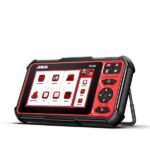Many car owners assume that all vehicles with a 16-pin diagnostic port, often referred to as an OBD2 port, operate in the same way when it comes to diagnostics. However, when dealing with older Mercedes-Benz models like the 1999 C230, this assumption can lead to misunderstandings and frustration, especially when trying to use standard OBD2 scanners. It’s crucial to understand that while the 1999 C230 does have a 16-pin diagnostic port, its communication system is not fully aligned with the modern CAN Bus systems found in newer vehicles.
The Myth of Universal OBD2 on Older Mercedes
The misconception arises because the 16-pin port visually resembles the standardized OBD2 port. Many believe that plugging in any generic OBD2 scanner will provide comprehensive diagnostic information. This is simply not the case for the 1999 C230 and similar era Mercedes models (like the R170 SLK). These vehicles, while equipped with sophisticated electronic systems for their time, utilize a more primitive communication protocol through the diagnostic socket, primarily relying on K-line communication rather than the Controller Area Network (CAN Bus) that defines modern OBD2 systems.
K-Line Communication: The Diagnostic Language of the 1999 C230
Unlike newer cars that transmit data across various modules via a high-speed CAN Bus network connected to the diagnostic port, the 1999 C230’s diagnostic port communicates with modules using K-lines. These K-lines are essentially single-wire communication pathways. While various electronic modules within the car, such as the engine control unit (ME 2.8), transmission control, ABS, airbag system (SRS), and climate control (HVAC), do communicate with each other using internal CAN Bus networks (like Powertrain CAN and Body CAN), these networks are not directly connected to the 16-pin diagnostic socket via CAN.
This means a standard OBD2 scanner, designed to interface with CAN Bus systems through the diagnostic port, will have limited access to the 1999 C230’s systems. These basic scanners typically only establish a K-line communication with the engine control unit (ME) and perhaps a few other primary modules like the SRS, ABS/ESP, and transmission control.
Limitations of Generic OBD2 Scanners on the 1999 C230
Using a basic OBD2 scanner on a 1999 C230 will likely only retrieve a limited set of generic fault codes and basic live data, primarily from the engine management system. You might be able to read engine-related trouble codes and perhaps clear the “Check Engine Light.” However, you will miss out on a vast amount of diagnostic information crucial for effectively troubleshooting many issues.
Standard OBD2 scanners will likely not access many other modules present in the 1999 C230, such as:
- Electronic Stability Program (ESP)
- Brake Assist System (BAS)
- Brake Booster Vacuum System
- Fuel Tank Pressure System
- Ignition Control Module (ICM)
- Anti-theft system (DAS-RF)
- Heating, Ventilation, and Air Conditioning (HVAC)
- Pneumatic System Equipment (PSE)
- Central Control Module (CCM)
- Supplemental Restraint System (SRS)
- Teleaid
- Audio systems
- Headlamp Range Adjustment (HRA)
These modules, while present in the vehicle, often communicate via different K-lines, and a generic OBD2 scanner lacks the sophisticated protocols and deeper access to interpret these specific communication languages.
The Need for Advanced Diagnostic Tools: SDS and Beyond
For comprehensive diagnostics, troubleshooting, and repairs on a 1999 C230, professional-grade diagnostic tools are essential. Mercedes-Benz’s own diagnostic system, known as Star Diagnosis System (SDS) or its successors, is specifically designed to communicate with these older models effectively.
SDS and similar advanced tools offer:
- Complete System Access: They can communicate with virtually all modules in the vehicle, not just a select few.
- Detailed Fault Codes: Access to manufacturer-specific fault codes beyond the generic OBD2 codes, providing much more granular information.
- Live Data from All Modules: Comprehensive real-time data from all accessible systems.
- Actuation Tests: The ability to activate and test individual components and systems.
- Adaptations and Coding: Functions for module programming, variant coding to match vehicle-specific equipment, and SCN coding for software calibration.
- Guided Diagnostics: Step-by-step troubleshooting procedures.
- Access to Workshop Manuals and Parts Catalogs: Integrated resources for repair information and parts identification.
Conclusion: Understanding Your 1999 C230’s Diagnostic Port
While the 1999 C230 features a 16-pin diagnostic port that physically resembles an OBD2 port, it’s crucial to recognize the limitations of standard OBD2 scanners on this vehicle. The diagnostic system relies on K-line communication, which is less comprehensive than the CAN Bus systems used in modern OBD2 compliant cars.
For basic engine fault code reading, a generic scanner might suffice. However, for in-depth diagnostics, troubleshooting complex issues, and accessing the full potential of your 1999 C230’s electronic systems, investing in or seeking services that utilize professional diagnostic equipment like SDS is highly recommended. Understanding this difference will save you time, money, and frustration when maintaining and repairing your classic Mercedes-Benz.
